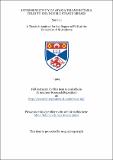Files in this item
Hypersensitivity of ataxia telangiectasia cells to DNA double strand breaks
Item metadata
| dc.contributor.advisor | Bryant, Peter Edward | |
| dc.contributor.author | Liu, Nan | |
| dc.coverage.spatial | 380 p. | en_US |
| dc.date.accessioned | 2018-06-11T13:32:40Z | |
| dc.date.available | 2018-06-11T13:32:40Z | |
| dc.date.issued | 1994 | |
| dc.identifier.uri | https://hdl.handle.net/10023/13905 | |
| dc.description.abstract | Cells of ataxia telangiectasia (AT) individuals are hypersensitive to a variety of DNA damaging agents such as ionizing radiation and bleomycin, presumed to be due to an intrinsic defect in repair of DNA damage. The nature of the DNA lesion(s) to which AT cells are abnormally sensitive, and the defect in DNA repair are presently unclear. The major part of this project aimed at investigating the sensitivity of AT cells to DNA double-strand breaks (dsb) generated by restriction endonucleases (RE), thereby verifying the hypothesis that AT cells are deficient in the processing of dsb. AT lymphoblastoid cell lines (AT-PA and AT-KM) used in this study were initially characterized and found to be approximately 3 times more sensitive to ionizing radiation in the induction of micronuclei (Mn) and chromosomal aberrations (CA) compared with a normal lymphoblastoid cell line (N-SW). Other cellular characteristics were observed in AT-PA cells following-irradiation such as normal induction and rejoining of dsb and reduced inhibition of DNA synthesis. By using SLO poration, RE were introduced into the AT and normal cell lines and the yield of CA resulting from RE-induced dsb were subsequently investigated. The frequencies of CA induced by Pvu II were 2 - 4 fold higher in AT-PA than in N-SW cells at both 5 h and 24 h sampling times. The enhanced frequency of CA in AT cells treated with Pvu II was principally a result of an increase of chromatid aberrations, rather than chromosome aberrations at 24 h. higher frequencies of chromatid exchanges appeared in AT-PA than in N-SW cells. The results suggest that AT cells are characterized by a defect in dsb processing that converts a higher number of dsb into CA than in the normal cell line. With respect to the different end-structures of RE-induced dsb, cohesive-ended dsb generated by BamH I and Pst I were found to induce lower frequencies of CA than blunt-ended dsb generated by Pvu II and EcoR V in both the AT cell lines and the normal cell line. The results support the previous observations that cohesive-ended dsb are less clastogenic than blunt-ended dsb (Bryant 1984). Although inducing lower frequencies of CA than Pvu II and EcoR V, BamH I and Pst I induced higher number of CA in both AT-PA and AT-KM cells when compared with N-SW cells, again indicating a defect in processing cohesive-ended dsb exists in AT cells. A potent DNA repair inhibitor, Ara A, was found to potentiate the production of CA by RE in AT and normal cells. The enhancement ratios (by ara A) for CA induced by Pvu II and Pst 1 were higher in N-SW cells than in AT-PA and AT-KM cells. Ara A appeared to have no effect on the frequencies of CA induced by BamH I in any of the cell lines tested. Based on these findings, a mechanism for the rejoining of RE-induced dsb in which DNA repair synthesis may be involved is proposed, and it is postulated that dsb in AT cells are subjected to greater end degradation. Inhibition of DNA synthesis was observed in normal cells after treatment with Pvu II and EcoR V, while EcoR I and BamH I had only minor effect. AT-PA cells were found to be resistant to RE-induced inhibition of DNA synthesis, as in the case of ionizing radiation. This result suggests that RE-induced blunt-ended dsb mimic radiation-induced lesions in supressing DNA synthesis in normal cells and that AT cells respond to RE-induced dsb in a similar way to damage induced by ionizing radiation. Finally, when a nuclear extract from N-SW cells was introduced into Pvu Il-treated AT-PA cells, it was able to confer a normal frequency of CA. In contrast, neither whole cell nor nuclear extracts from normal cells influenced the production of CA induced by y-rays. These findings provide evidence for the presence of factor(s) in normal nuclear extract which complements the defect in processing of RE-induced dsb in AT cells. | en_US |
| dc.language.iso | en | en_US |
| dc.publisher | University of St Andrews | |
| dc.subject.lcc | QH465.C7 | en |
| dc.subject.lcsh | DNA damage | en |
| dc.title | Hypersensitivity of ataxia telangiectasia cells to DNA double strand breaks | en_US |
| dc.type | Thesis | en_US |
| dc.contributor.sponsor | Committee of Vice-Chancellors and Principals of the Universities of the United Kingdom Overseas Research Scholarship | en_US |
| dc.contributor.sponsor | Maitland Ramsay studentship fund | en_US |
| dc.type.qualificationlevel | Doctoral | en_US |
| dc.type.qualificationname | PhD Doctor of Philosophy | en_US |
| dc.publisher.institution | The University of St Andrews | en_US |
This item appears in the following Collection(s)
Items in the St Andrews Research Repository are protected by copyright, with all rights reserved, unless otherwise indicated.

